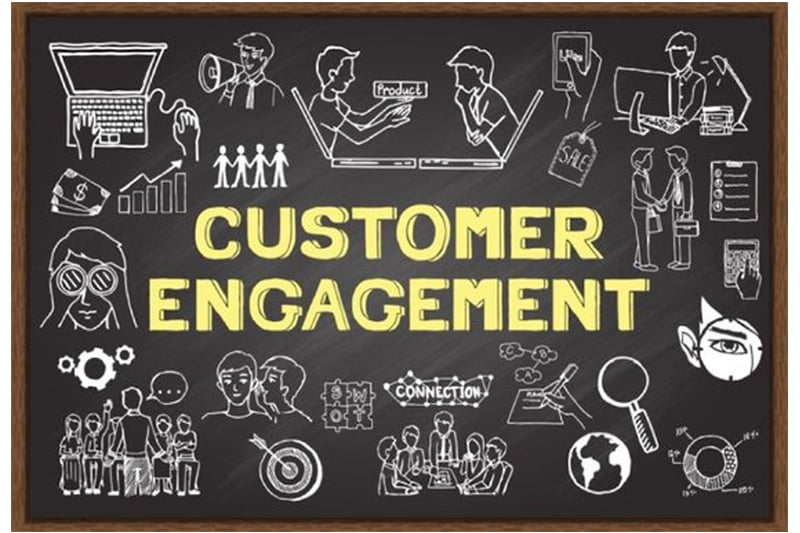
What is customer engagement?
Introduction
When improving customer relations, we typically think about service and support rather than customer engagement. However, this goes beyond high-quality customer service. Delighting customers and encouraging them to spend more money with your brand isn’t enough. In fact, this could make them feel transactional and less meaningful to your company.
“What does customer engagement” truly signifies?
Although there are plenty of definitions for the buzzword “engagement”, they all have one thing in common. Customer engagement is everything related to the interaction between a company and customers. Paul Greenberg was spot on with his definition:
According to this definition, clients choose the way they’d like to be engaged with individually. This is a good point – in giving customers the option to choose, they are much more likely to find an approach that they deem beneficial.
As a result, they strengthen their emotional investment in your company. This is a good way to build better customer relationships. Without connecting on a deeper level, it takes a much longer time for a customer to buy a product, if at all
In this post, we’ll discuss everything you need to know about customer engagement, , and how it can enhance customer relations in your organization.
Based on this guide, it’s clear that customer engagement positively impacts your business and ensures a stronger customer base. However, it’s not so simple to just jump right in.
1.Share valuable content

It should address their unique pain points or be relevant to their business niche.
Before writing your content piece, ask yourself why they would want to read or share it.
If you want to make your content more engaging, a rule of thumb is to focus on educating your customers. “How-to” tutorials are interesting and relevant, because customers come to you because they need something done that they can’t do on their own.
If you continuously solve your customers’ problems via content, your brand name becomes apposite with problem-solving.
2.Establish an emotional connection

Even if your company’s product is software, your clients still need to feel some emotion coming from your brand. By adding a human touch, you position your company as more P2P than B2B.
Here are a few ways you can engage your customers while showing a human side at the same time:
Make a personal connection- Customer engagement is about personal treatment. For example, try to personalize your emails.
This helps a recipient feel as if you’re referring to them individually; everyone wants to feel as if they are the only one in an audience. Addressing a customer by name is the first step to building trust.
Utilize easy-to-obtain data for gender, age, date of birth, and location, and create variables in a mailing list. Remember to congratulate your clients on their birthdays, at New Year, and for other holidays.
Smart personalization allows you to use email templates, but send emails containing different information or images based on different variables
Introduce yourself- Regardless of whether you have a new lead or follower, always welcome them by sending them a brief and personalized message.
Include a virtual business card, your email signature, at the end your email to make it easy for a prospect to learn more about you.
Ask questions- Want your clients to interact with you? What’s a better way than by simply asking a question? Questions are a nice opportunity not only to grab the client’s attention, but to pick their brains.
Here are some ideas for question topics you can ask your clients about:
- How their experience was of your product, how they’ve benefited from it, and what needs to be improved.
- Ask them to share the apps that they need to run business.
- Find out what challenges and pain points they’re facing.
- Discover what tips they’d give others in their industry.
- Learn what their favorite types of podcast or other media are.
Make videos- These days, it’s easy to create any type of content. Users tend to find short videos more comfortable than a long-winded blog post.
Therefore, it’s best to use videos to demonstrate and promote a product. A video can be about anything: how-to, webinars, and customer success stories are some of the genres that we have found most effective.
What’s more, it’s a good and relatively fresh idea for businesses to post Instagram stories, go live to answer clients’ questions, or simply to talk about relevant topics.
3. Be active on social media

You can publish behind-the-scenes content from office or community events. For the sake of staying fresh in your customers’ minds, you should always have a little something extra in your back pocket to give them.
Getting your audience used to a weekly blog post on Instagram or Facebook, or a daily share of interesting content through LinkedIn or Twitter helps build familiarity and loyalty.
To encourage this, having a carefully planned content calendar helps get your content team posting top content on a regular basis.
So what kind of content should you offer?
Specific- Write posts on social media about specific subject matters. More original content is always a winner, rather than offering the same topics that have already been covered to death.
If your subject matter is more customer-driven, then it is more likely to resonate with your audience.
Apart from product-related topics, you might want to express your own opinion on relevant issues, share news, and encourage discussion, fostering a reaction from readers in likes, comments, and shares.
Advantages- Saving customers’ time should always be a priority. When they read through a blog post or watch a tutorial, there needs to be some sort of reward at the end of it.
Your readers should come away feeling empowered by being able to do something they couldn’t do before. Always try to enrich social media posts with value for both users and prospects.
Entertaining- It’s almost impossible to engage a bored customer. Adding a friendly, lighthearted tone to interactions helps customers to feel more comfortable with you; again, developing a more emotional connection.
Crack a joke, include a funny video, or attach a meme to your next post. Your humor can either be related to a specific industry, or you can choose an alternative topic to catch the attention of a broader scope of followers.
4. Be a Doctor for your clients

What problems are you actually trying to solve?
For your conversation to resonate with a user, it needs to be less focused on purchasing a product or service, or how great your company is, and more focused on meeting specific needs.
As mentioned above, you can learn about a clients’ pain points through social media. Ask what they feel is lacking from their everyday routine that could achieve better workflow.
The key here is to really listen to every response and provide practical and actionable advice. If you know that a prospect is interested in your service, offer them a demo – a live helping hand and assist them in all the painful questions.
5. Give presents

You could offer a special birthday discount to users.
Highlight the most active users each month and provide a special offer to them in return for their unwavering support.
Alternatively, when celebrating your company’s birthday, you could invite your partners and clients to an exclusive anniversary party.
If you don’t feel much like partying, simply offer them a one-time discount to mark the milestone.
These offers are always a pleasant surprise for customers, helping them feel as if they’re part of the team and everybody likes saving a little bit of money.
Now that you understand the steps of customer engagement, Follow the tactics in this blog to build a customer experience that will keep your brand top of mind for new and existing customers.
Conclusion
In conclusion, customer engagement isn’t just a business strategy; it’s the heartbeat of sustainable growth and enduring relationships.
As you embark on this journey, remember that the more you invest in engaging with your customers, the more they’ll invest in your success.
So, go ahead, nurture those connections, listen to their voices, and watch your business thrive in the warm embrace of customer engagement.
Here’s to building a future where every interaction leaves a lasting impression, and every customer becomes an advocate for your brand.











